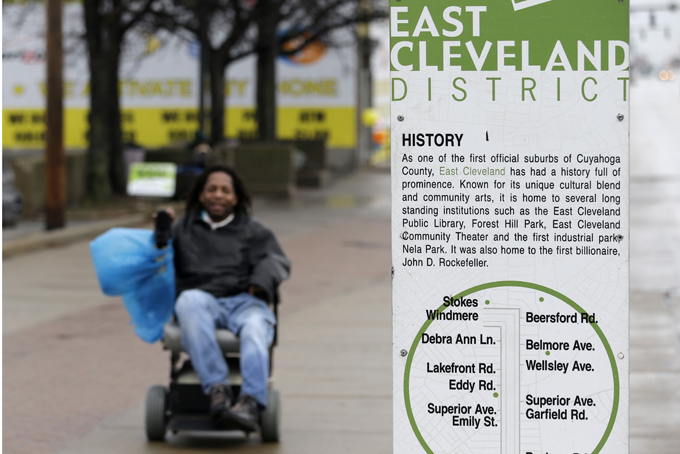
EAST CLEVELAND, Ohio (AP) — East Cleveland has long been one of the poorest cities in the state, a model for what urban decay looks like — streets filled with blighted and boarded-up homes and tired commercial districts.
And it’s beyond broke.
The city government’s cellphone provider recently cut off service for nonpayment. It is getting two new salt trucks purchased with federal money but won’t be able to fill them because of what it owes Morton Salt Inc., one of the city’s fiscal overseers said.
This city of 17,000 people is now considering whether to file for municipal bankruptcy, which would be a first for an Ohio municipality.
East Cleveland in recent years lost two of its biggest employers and the income taxes paid by those who worked there. East Cleveland’s bottom line has been further diminished by substantial cuts in state funding and a countywide reappraisal that further reduced property tax receipts.
The Cleveland suburb has been under a state-ordered fiscal emergency since 2012, which means a fiscal commission oversees the city’s finances and works with officials to devise a recovery plan. East Cleveland has been there before. It was under a fiscal emergency from 1988 until 2006, the longest in state history.
The city’s financial woes have reached a point where the head of the fiscal commission doesn’t think bankruptcy would even help. Sharon Hanrahan of the Ohio Office of Management and Budget said she’s concerned the city won’t have enough cash in the bank to make payroll for the first pay period of 2015.
Mayor Gary Norton said a bankruptcy filing is being considered.
“We have to recognize the reality we face, weigh our options and choose a course,” Norton said in an interview with The Associated Press. “Right now, we’re in the stage of weighing our options.”
He bristled at the notion that East Cleveland won’t make payroll, noting that doomsayers have been predicting such a thing for months. He emphasized that city government is still delivering essential police, fire and emergency medical services and is picking up residents’ trash.
There have been fewer than 500 government-related bankruptcies in the country since 1934, when bankruptcy laws took effect during the Great Depression. Detroit recently emerged from the country’s largest-ever municipal bankruptcy after piling up $7 billion in debt.
Hanrahan said East Cleveland can’t be compared with Detroit because East Cleveland has so few resources. The city has negative fund balances of about $5 million and more than $2 million in past-due bills.
In a letter to the East Cleveland fiscal commission dated Nov. 21, Ohio Auditor Dave Yost wrote: “During 2014, only sheer luck has kept (East Cleveland) from the one unexpected expense that would jeopardize payroll.”
Yost further wrote that the city’s recovery plan is “unworkable.” The letter said there is anecdotal evidence that doctors are refusing to treat city workers because medical bills have gone unpaid.
The aftermath of a municipal bankruptcy can be ugly, Hanrahan said. She pointed to Vallejo, California, which emerged from bankruptcy in 2011 but may have to file again. That city had to make deep cuts in safety services and has watched crime rise and city streets go neglected.
A bankruptcy would result in East Cleveland’s debtors getting whatever a judge decides. But it won’t change East Cleveland’s primary condition — a poor city that appears to be growing poorer.
Hanrahan said a municipal bankruptcy can work under “certain circumstances.”
“And I don’t think the circumstances exist in East Cleveland,” she said.